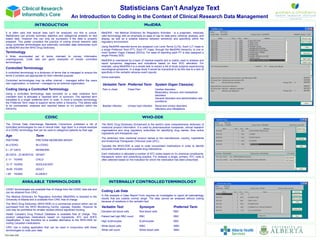
Statisticians Can\'t Analyze Text!
- 1. Statisticians Can’t Analyze Text An Introduction to Coding in the Context of Clinical Research Data Management INTRODUCTION MedDRA It is often said that textual data can’t be analyzed, but this is untrue. MedDRA - the Medical Dictionary for Regulatory Activities - is a pragmatic, medically Statisticians can provide summary statistics and categorical analysis on text valid terminology with an emphasis on ease of use for data entry, retrieval, analysis, and based data. However this can only be successful if the data is properly display, as well as a suitable balance between sensitivity and specificity within the prepared. This poster considers the practice of coding clinical research data regulatory environment. using controlled terminologies and externally controlled data dictionaries such as MedDRA and the WHO Drug Dictionary. Using MedDRA reported terms are assigned Low Level Terms (LLTs). Each LLT maps to a single Preferred Term (PT). Each PT maps, through the MedDRA hierarchy, to one or Terminology more System Organ Classes (SOCs). For ease of reporting each PT is also assigned a A finite, enumerated set of terms intended to convey information single Primary SOC. unambiguously. Code lists are good examples of simple controlled MedDRA is maintained by a team of medical experts and is mainly used to analyse and terminologies. report symptoms, diagnoses and indications based on their SOC allocation. For example, using MedDRA it is a simple task to extract a list of study subjects experiencing Controlled Terminology neurological symptoms. In a large study it would be impractical to do this due to a lack of A controlled terminology is a dictionary of terms that is managed to ensure the specificity in the verbatim adverse event reports.. terms it contains are appropriate for their intended purpose. Some examples: Controlled terminologies may be either internal – managed within the users own organization, or external – managed by an external organization. Verbatim Term Preferred Term System Organ Class(es) Coding Using a Controlled Terminology Pain in chest Chest Pain Cardiac disorders Respiratory, thoracic and mediastinal Using a controlled terminology data recorded on a data collection form disorders (verbatim text) is allocated a ‘reported term’ or synonym. The reported term General disorders and administration site translates to a single ‘preferred term’ or code. In more a complex terminology conditions the Preferred Term maps to superior terms within a hierarchy. This allows data to be summarised, analysed and reported based on it’s position within the Bladder infection Urinary tract infection Renal and urinary disorders hierarchy. Infections and infestations CDISC WHO-DDE The Clinical Data Interchange Standards Consortium publishes a list of The WHO Drug Dictionary (Enhanced) is the world’s most comprehensive dictionary of controlled terminologies for use in clinical trials. ‘Age Span’ is a simple example medicinal product information. It is used by pharmaceutical companies, clinical research of a CDISC terminology that can be used to categorize patients by their age. organisations and drug regulatory authorities for identifying drug names, their active ingredients and therapeutic use. Age Term The dictionary links medicinal product names to the manufacturer, country, ingredients PRETERM PRETERM NEWBORN INFANT and Anatomical Therapeutic Chemical code (ATC). IN UTERO IN UTERO Typically the WHO-DDE is used to code concomitant medications in order to identify 0 – 27 DAYS NEWBORN excluded medications and possible drug interactions. 28 DAYS - 23 MONTHS INFANT Each medication is allocated a number of ATC codes based on it’s chemical constituents, therapeutic action and prescribing practice. For analysis a single, primary, ATC code is 2 -11 YEARS CHILD often selected based on the indication for which the medication has been prescribed. 12-17 YEARS ADOLESCENT 18-65 YEARS ADULT > 65 YEARS ELDERLY AVAILABLE TERMINOLOGIES INTERNALLY CONTROLLED TERMINOLOGY CDISC terminologies are available free of charge from the CDISC web site and can be obtained from CRIC. Coding Lab Data The Medical Dictionary for Regulatory Activities (MedDRA) is licensed to the In this example a Case Report Form requires an investigator to report all haematology University of Alberta and is available from CRIC free of charge. results that are outside normal range. The data cannot be analysed without coding because of variations in the verbatim text. The WHO Drug Dictionary (WHO-DDE) is a commercial product which can be purchased from the WHO Monitoring Centre, Uppsala, Sweden. However its Verbatim Text Synonym Preferred Term cost may be prohibitive for smaller studies without significant funding. Elevated red blood cells Red blood cells RBC Health Canada’s Drug Product Database is available free of charge. This product categorises medications based on ingredients, ATC and AHFS Patient had high RBC count RBC RBC classification. It may therefore be a suitable alternative to the WHO-DDE for High erythrocytes Erythrocytes RBC coding Canadian medications. White blood cells WBC WBC CRIC has a coding application that can be used in conjunction with these terminologies to code your data. White cell count White blood cells WBC Rick Watts 2008
